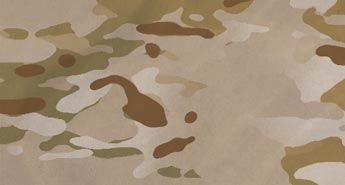Multicam® Arid camo pattern
Just like other camouflage patterns in this series, the Multicam® Arid pattern was created to minimize the visual impression of an individual wearing it. It is effective not only in normal visible light but also covers a person's Near-IR signature (see below for more on this topic).

Country of application: It is a camouflage pattern coming from a private company, so anyone who requests it can have it. However, it has also caught the attention of some armies – most recently the US Army, where one camouflage pattern from the series (the classic MultiCam®) served well as a universal camouflage in Afghanistan.
Unlike the common standard Multicam® camouflage pattern, the Multicam® Arid pattern is primarily intended for open areas that are predominantly sandy and rocky. The design and palette of MultiCam Arid™ nicely complement and partially overlap with the regular MultiCam® camouflage pattern. What does this mean in practice? It's simple: when you pair equipment from the MultiCam® series with MultiCam Arid™, they visually complement and support each other in camouflage. It's an extremely thoughtful and effective way of individual protection.
What is Near-IR signature and why is it used?
In connection with the Near-IR signature, the abbreviation NIRS is used, which literally translates to: "Near-Infrared Spectroscopy." As its name suggests, it is a spectroscopic method focusing on areas known as the near-infrared part. It corresponds to wavelengths from 800 nm to 2500 nm. And why is it used for a variety of activities? Because unlike mid-infrared spectroscopy, NIRS penetrates deeper.
Even though it may not be an extremely sensitive diagnostic method, it has numerous other advantages. Unlike other methods, there is no need to further modify and prepare the sample before processing and studying it. Another advantage – its use is quite widespread today. Primarily, we must mention modern medical diagnostics in all its forms (blood sugar levels, oximetry, etc.). However, its application doesn't end there – you would also find it in pharmacy, agrochemistry, it's used within the food control system, and also in the study of substance combustion. It also performs well in brain research in newborns, where it is logical not to use anything too harmful (such as the slightly controversial PET or fMRI methods). Some countries have even banned them entirely.
For medicine, it is also useful that the detectors of this spectrometer can be very small. Conversely, its accuracy remains quite respectable.




























































































































